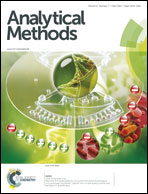An integral evaluation method for synchronous drug release based on a mathematics set in guiding the preparation of multi-component traditional Chinese medicine†
Abstract
The quantitative characterization and evaluation of the synchrony of multi-component release behavior are bottlenecks which urgently need to be solved in the study of multi-component release kinetics and the quality control of multi-component traditional Chinese medicine (MCTCM). MCTCM is made using original prescriptions and preparations. At present, MCTCM is generally evaluated using pharmacodynamics evaluation. However, this method lacks convenience and cannot clearly reveal the correlation between the whole dynamic process of drug release and in vivo absorption. It is also very limited by the preparation of MCTCM. In addition, there are various types of effective ingredients in MCTCM, which show distinctly different physicochemical properties. These differences may lead to the asynchrony of drug release between MCTCM and the original preparation, which thereby directly affects the efficacy. However, we can't find the core reason for this issue through the use of pharmacodynamics evaluation. The papers reported previously were confined to studying the release characteristics of one or a few components in MCTCM and the drug release evaluation method reported was too macroscopic to specifically identify the components which caused the integral asynchrony. In this paper, in order to reveal the MCTCM release synchronous characteristics, Fuzhenghuayu capsules were selected as the model, an original preparation used, and the integral release evaluation method based on a mathematics set was established in guiding the preparation of MCTCM. This method can not only be used in evaluating the release characteristics of MCTCM by the parameter of the asynchronous coefficient, but can also be used in adjusting the dose of the release unit by the relative error parameter. The results demonstrated that this evaluation method was feasible, stable and reproducible. Also the Fuzhenghuayu pellets guided by this method showed release synchrony and similar pharmacodynamics with the original capsules, and the drug release mechanism was mainly frame erosion. Through this study, we could then evaluate the quantifiable release characteristics of MCTCM and apply an integral synchronous evaluation method for MCTCM.


 Please wait while we load your content...
Please wait while we load your content...